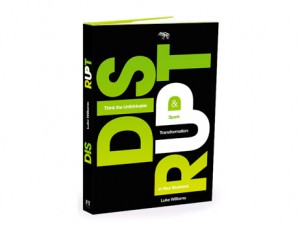Yesterday I had the chance to read Disrupt: Think the Unthinkable to Spark Transformation in Your Business by Luke Williams. This book was a great read because it challenges leaders to ask the questions that people haven’t even thought of yet. Rather than just making subtle changes in your business model, Williams encourages you to truly disrupt your way of thinking in an effort to truly be an innovator in your industry. This book is a great read for anyone that desires to truly make a difference by being on the the cutting edge when it comes to outhinking the needs and desires of your customer. As someone that is currently working on a few disruptive ideas, this book was a great resource!
Here are some things that I highlighted while reading…
- Figuring out a way to be the only one who does what you do is a provocative goal, but it’s absolutely unobtainable unless you make some significant changes to the way you think about competition and the business you’re in.
- Think what no one else is thinking, and do what no one else is doing.
- Craft a disruptive hypothesis.
- Define a disruptive market opportunity.
- Generate several disruptive ideas.
- Shape them into a single, disruptive solution.
- Make a disruptive pitch that will persuade internal or external stakeholders to invest or adopt what you’ve created.
- A disruptive hypothesis is an intentionally unreasonable statement that gets your thinking flowing in a different direction.
- The ability to imagine things as they never were and ask, “What if?,” is essential.
- As we go through the process of doing a little disrupting of our own, I want you to keep in mind the three following questions: 1. What do you want to disrupt? 2. What are the clichés? 3. What are your disruptive hypotheses?
- “How can we disrupt the competitive landscape of [insert your situation] by delivering an unexpected solution?”
- What is abundant that could be made scarce? What is expensive that could be free?
- Being insightful isn’t a question of talent; it’s a question of awareness.
- Awareness is essentially being mindful of the cultural and social constructs that surround you and the people for whom you are creating something new.
- What is the social network of the customer?
- What is the level of customer support offered?
- So, instead of large pain points, you should spend your time looking for—and addressing—something much more subtle: small “tension points,” the things that aren’t big enough to be considered problems.
- Set up an “Insight Board.”
- Organize observations into themes so you can lay the foundation for generating insights.
- Wherever there’s tension (observation), there’s a gap. If you can spot the gap (insight), you can fill the void (opportunity).
- The first purpose of this research is to observe, identify, and record tension points. The second is to cultivate insights that highlight gaps between the way something is now and the way it ought to be. The third is to work out opportunities to fill the gaps.
- “Imagination is more important than knowledge.” —Albert Einstein
- Hypotheses feed observations. Observations feed insights. Insights feed opportunities. Opportunities feed ideas.
- Many significant innovations got their start as unexpected discoveries or impractical ideas.
- It’s not enough just to come up with something disruptive; it has to be disruptive in ways that are valued by users.
- To get from disruptive idea to practical solution, actively involve end users to test and review.
- Never review the results of an iteration cycle by yourself.
- Shift the focus of your audience from the need for disruptive change to the motivation for disruptive change.


